Abstract
The inoculation of Aspergillus flavus spores into a culture of Streptococcus lactis in Lablemco tryptone broth medium resulted in little or no aflatoxin accumulation even though the growth of the fungus was not hindered. The drop in pH and reduced nutrient levels in the medium as a result of the S. lactis growth were not the cause of the observed inhibition. The inhibition was not eliminated by the addition of carbohydrate equal to the amount used by the bacterium before the inoculation with the fungus. Aflatoxin levels were also markedly reduced when S. lactis was inoculated into a growing A. flavus culture. In addition to inhibiting the synthesis of aflatoxin, S. lactis also degraded preformed toxin. A. flavus, on the other hand, not only reduced the growth of S. lactis but also affected the morphology of the bacterial cell; the cells became elongated and formed long chains. S. lactis produced and excreted the inhibitor into the medium late in its growth phase. The inhibitor was a heat-stable low-molecular-weight compound. Chloroform extracts of A. flavus grown in the presence of S. lactis were toxic to Bacillus megaterium but did not exhibit mutagenic or carcinogenic activity in the Salmonella/mammalian microsome mutagenicity test.
Full text
PDF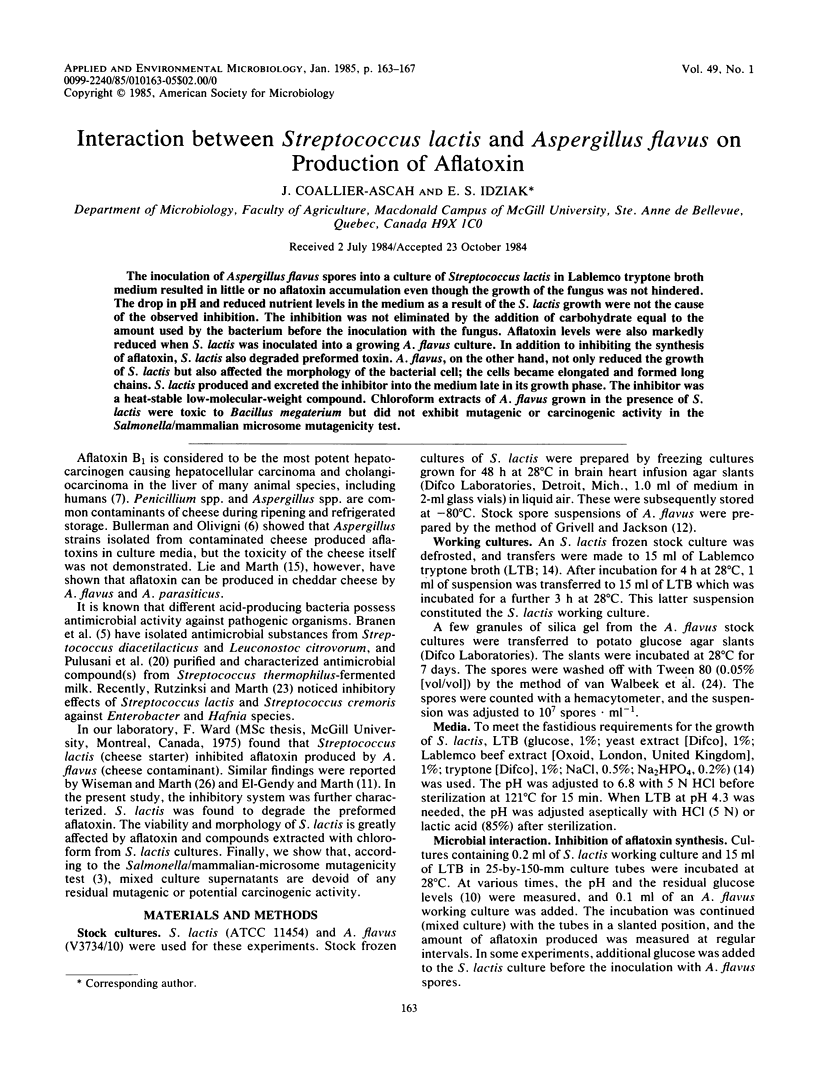
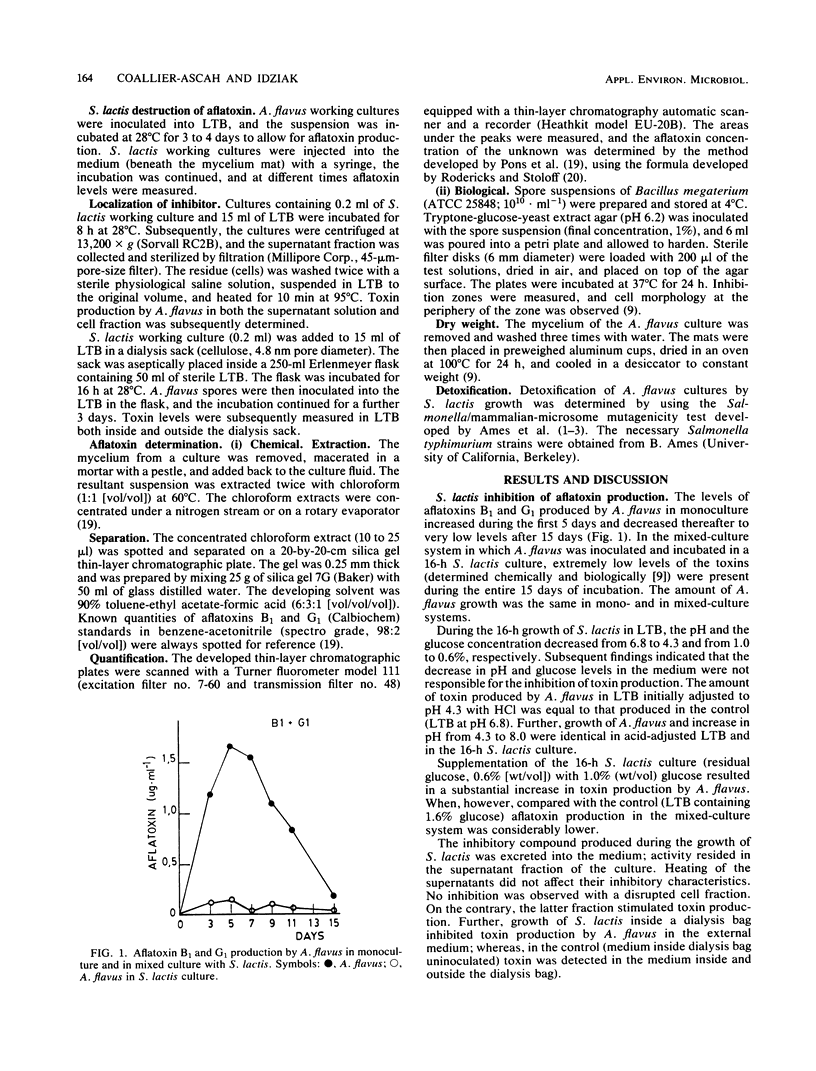
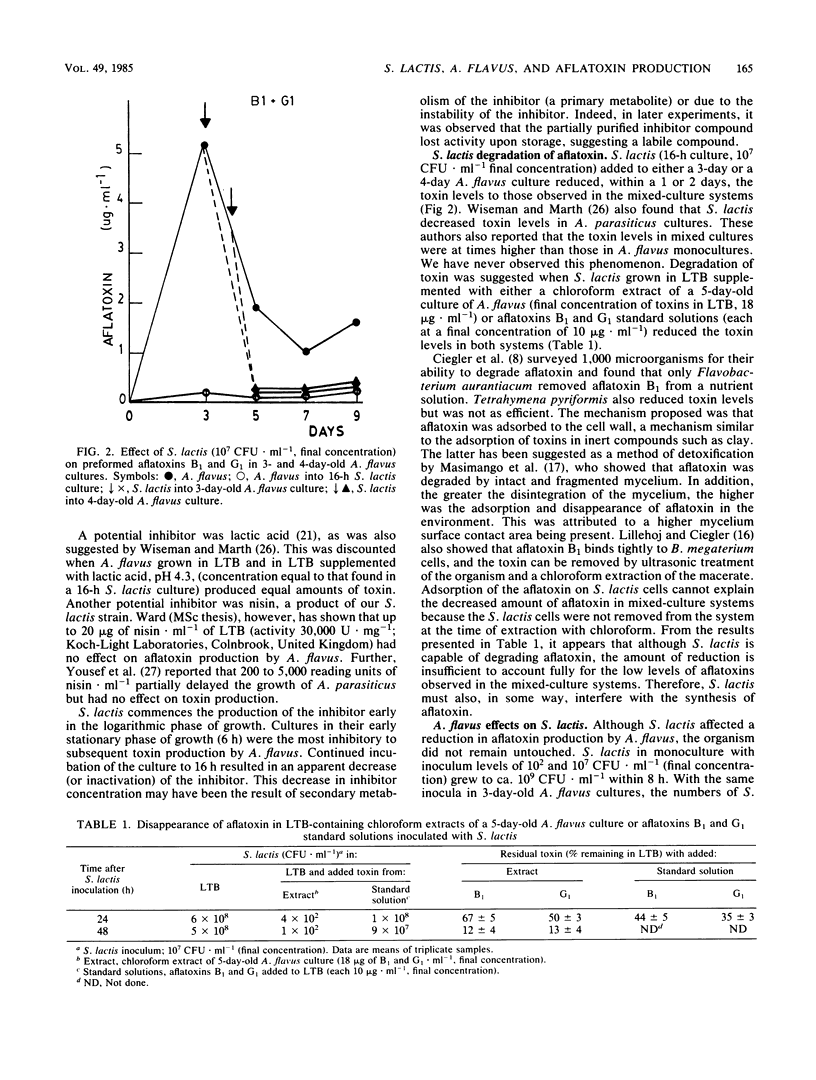
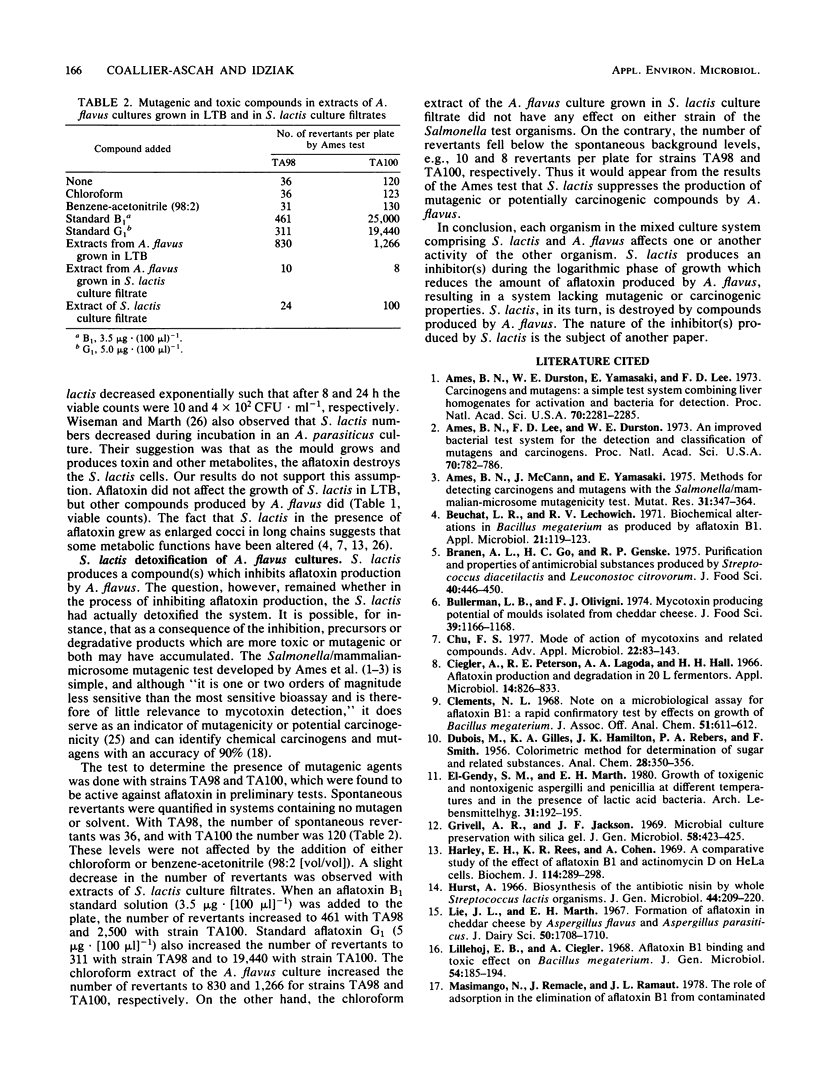
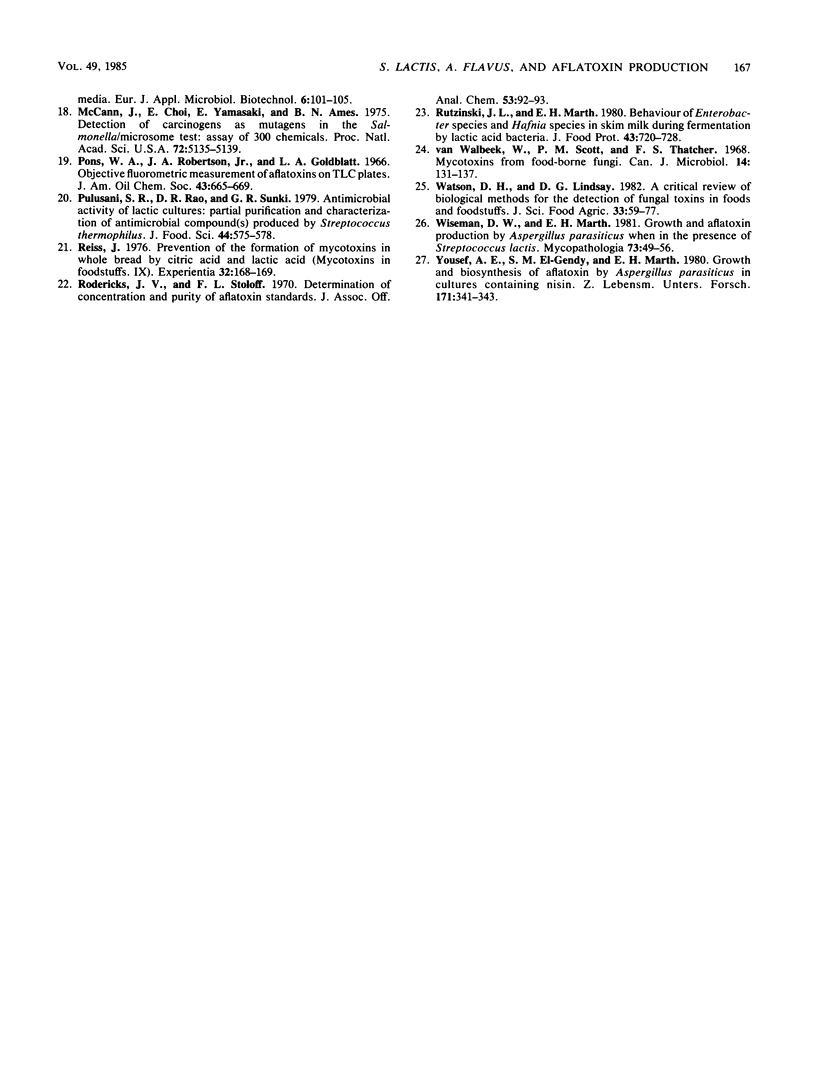
Selected References
These references are in PubMed. This may not be the complete list of references from this article.
- Ames B. N., Durston W. E., Yamasaki E., Lee F. D. Carcinogens are mutagens: a simple test system combining liver homogenates for activation and bacteria for detection. Proc Natl Acad Sci U S A. 1973 Aug;70(8):2281–2285. doi: 10.1073/pnas.70.8.2281. [DOI] [PMC free article] [PubMed] [Google Scholar]
- Ames B. N., Lee F. D., Durston W. E. An improved bacterial test system for the detection and classification of mutagens and carcinogens. Proc Natl Acad Sci U S A. 1973 Mar;70(3):782–786. doi: 10.1073/pnas.70.3.782. [DOI] [PMC free article] [PubMed] [Google Scholar]
- Ames B. N., Mccann J., Yamasaki E. Methods for detecting carcinogens and mutagens with the Salmonella/mammalian-microsome mutagenicity test. Mutat Res. 1975 Dec;31(6):347–364. doi: 10.1016/0165-1161(75)90046-1. [DOI] [PubMed] [Google Scholar]
- Beuchat L. R., Lechowich R. V. Biochemical alterations in Bacillus megaterium as produced by aflatoxin B1. Appl Microbiol. 1971 Jan;21(1):119–123. doi: 10.1128/am.21.1.119-123.1971. [DOI] [PMC free article] [PubMed] [Google Scholar]
- Chu F. S. Mode of action of mycotoxins and related compounds. Adv Appl Microbiol. 1977;22:83–143. doi: 10.1016/s0065-2164(08)70161-8. [DOI] [PubMed] [Google Scholar]
- Ciegler A., Peterson R. E., Lagoda A. A., Hall H. H. Aflatoxin production and degradation by Aspergillus flavus in 20-liter fermentors. Appl Microbiol. 1966 Sep;14(5):826–833. doi: 10.1128/am.14.5.826-833.1966. [DOI] [PMC free article] [PubMed] [Google Scholar]
- Grivell A. R., Jackson J. F. Microbial culture preservation with silica gel. J Gen Microbiol. 1969 Nov;58(3):423–425. doi: 10.1099/00221287-58-3-423. [DOI] [PubMed] [Google Scholar]
- Harley E. H., Rees K. R. A comparative study of the effect of aflatoxin B and actinomycin D on HeLa cells. Biochem J. 1969 Sep;114(2):289–298. doi: 10.1042/bj1140289. [DOI] [PMC free article] [PubMed] [Google Scholar]
- Hurst A. Biosynthesis of the antibiotic nisin by whole Streptococcus lactus organisms. J Gen Microbiol. 1966 Aug;44(2):209–220. doi: 10.1099/00221287-44-2-209. [DOI] [PubMed] [Google Scholar]
- Lie J. L., Marth E. H. Formation of aflatoxin in cheddar cheese by aspergillus flavus and aspergillus parasiticus. J Dairy Sci. 1967 Oct;50(10):1708–1710. doi: 10.3168/jds.S0022-0302(67)87698-7. [DOI] [PubMed] [Google Scholar]
- Lillehoj E. B., Ciegler A. Aflatoxin B1 binding and toxic effects on Bacillus megaterium. J Gen Microbiol. 1968 Dec;54(2):185–194. doi: 10.1099/00221287-54-2-185. [DOI] [PubMed] [Google Scholar]
- McCann J., Choi E., Yamasaki E., Ames B. N. Detection of carcinogens as mutagens in the Salmonella/microsome test: assay of 300 chemicals. Proc Natl Acad Sci U S A. 1975 Dec;72(12):5135–5139. doi: 10.1073/pnas.72.12.5135. [DOI] [PMC free article] [PubMed] [Google Scholar]
- Reiss J. Prevention of the formation of mycotoxins in whole wheat bread by citric acid and lactic acid. (Mycotoxins in foodstuffs. IX). Experientia. 1976 Feb 15;32(2):168–169. doi: 10.1007/BF01937745. [DOI] [PubMed] [Google Scholar]
- Van Walbeek W., Scott P. M., Thatcher F. S. Mycotoxins from food-borne fungi. Can J Microbiol. 1968 Feb;14(2):131–137. doi: 10.1139/m68-022. [DOI] [PubMed] [Google Scholar]
- Watson D. H., Lindsay D. G. A critical review of biological methods for the detection of fungal toxins in foods and foodstuffs. J Sci Food Agric. 1982 Jan;33(1):59–67. doi: 10.1002/jsfa.2740330112. [DOI] [PubMed] [Google Scholar]
- Wiseman D. W., Marth E. H. Growth and aflatoxin production by Aspergillus parasiticus when in the presence of Streptococcus lactis. Mycopathologia. 1981 Jan 30;73(1):49–56. doi: 10.1007/BF00443014. [DOI] [PubMed] [Google Scholar]
- Yousef A. E., El-Gendy S. M., Marth E. H. Growth and biosynthesis of aflatoxin by Aspergillus parasiticus in cultures containing nisin. Z Lebensm Unters Forsch. 1980;171(5):341–343. doi: 10.1007/BF01087128. [DOI] [PubMed] [Google Scholar]


